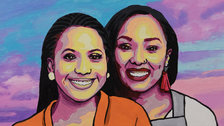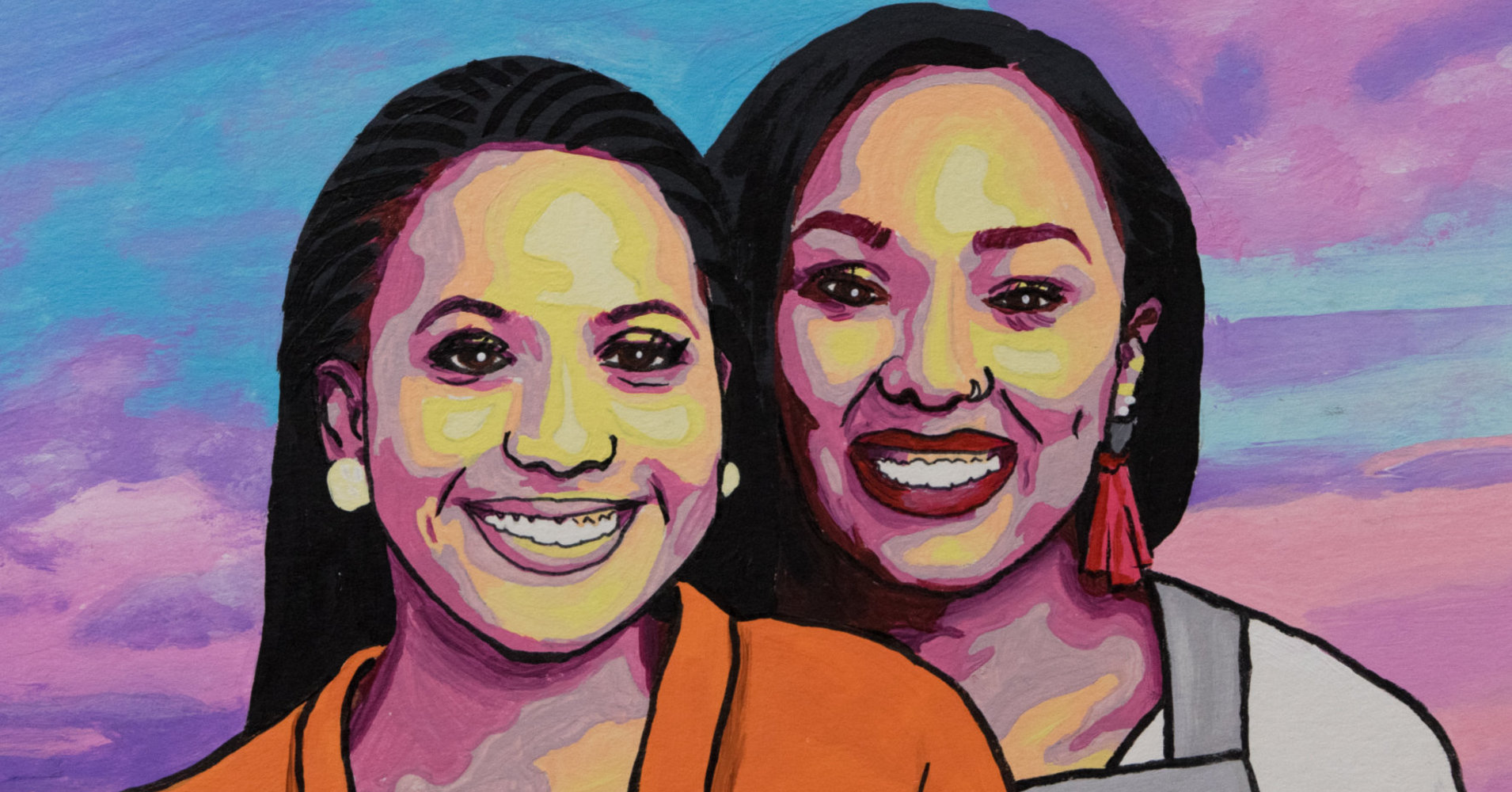[ad_1]

Preserving cultural ties to food while making it a bit healthier is paramount for registered dietitians Jessica Jones and Wendy Lopez. They understand the importance of maintaining the texture and flavor of your grandmother’s mac ’n’ cheese recipe — even if you’re creating a “cheese” sauce from cashews, sweet potatoes and nutritional yeast because you want to increase the dish’s nutrient value.
Jones and Lopez are close friends who founded their nutrition website, Food Heaven Made Easy — a brand that includes a podcast, cookbooks and several online kits — in 2011. It’s their primary tool to help educate folks, particularly black women and other people of color, on making food that is healthy and respects the culture it comes from. Their focus is developing recipes that are familiar with ingredients that are good for you as well as affordable and easy to find.
That stands in contrast to the bulk of messaging in the wellness industry, which often lacks cultural competence and inclusivity. It can be difficult for people of color to connect with healthy eating, especially when a recipe calls for ingredients that are inaccessible to folks who can’t afford to shop at Whole Foods.
“We’re intentional about creating content that sends the message that health is attainable for everyone — no matter what weight you are — and that weight doesn’t necessarily correlate with health,” Lopez said. “It’s especially useful for black women, because we are curvier. A lot of us are curvier naturally, and so I think black women connect more with that. And our audience is mostly black women.”
For Women’s History Month, HuffPost spoke with Jones and Lopez about the nuances of food preferences among people of color, the barriers to physical activity for black and brown folks and why it’s so important to make health and wellness enjoyable.
This interview has been edited for length and clarity.
Whenever you two are creating recipes and you want to re-create a cultural dish and make it healthy, what is the process of doing that? How do you get creative about it but still make it taste super-dope?
Lopez: Flavor is key, and so making sure that you’re still staying true to the flavors of that recipe, the textures of that recipe. It doesn’t have to be a complete turnaround. It could just be minor things that make it a little bit healthier and more balanced, but it still tastes like what the dish is supposed to taste like.
For example, I just redid a pasta recipe that called for heavy cream and four different types of cheeses. And so it’s about finding ways to still stay true to what the recipe is by using other ingredients that might be a little healthier to re-create the texture while still having the cheese in there. Using things like cashews or getting creative with the type of ingredients that are used to balance it out a little bit better. Sometimes it could be staying true to the original recipe and adding something like vegetables to it so that you are getting more nutrients.
You had dietitian Tamara Melton on the “Food Heaven” podcast a couple of months ago, and she was talking about how health is viewed through a Eurocentric lens. That was a very important thing to break down. How do you go about deconstructing Eurocentric notions of health — that health is for white people, that certain food is for white people?
Jones: A lot of people hit us up, whether it’s email or DM or an Instagram comment, and sometimes black women will say, “I used to think health and wellness wasn’t for me until I saw you guys and your content and realized that it actually is accessible.” But the way that you do that is, like Wendy was saying, by honoring someone’s culture and their preferences.
I still do one-on-one counseling with people, so if I’m doing a session, I’m never going to lead with “This is what you should do.” It’s more “So tell me what you already are doing.” I have a whole thing that I go through with people. I ask them what is the most satisfying meal they’ve had recently, why was it satisfying, what foods are you eating that you feel like you’re eating because you have to but not because they really bring you joy.
With asking those questions, it can help people realize that it’s OK to eat the food they grew up on. I had a patient who was having boba tea all the time. For him, it was very cultural because he used to have a specific boba tea with his grandfather. It was something that he and his friends, too, really enjoyed. That was the way that they bonded and shared meaningful memories and experiences. We don’t want to take that away, because that’s really important and that is something that feels really culturally relevant to that person. But what we can do is say, “OK, well, we know that having the boba tea every day is not going to be the best for your blood sugar. What if we do the boba tea just twice per week?”
It doesn’t always have to be so extreme or black and white.
How do you encourage people to get into physical activity? Because, at least for me, that was a whole ’nother barrier from food. Not only did I have to deconstruct that this is “white people food,” I had to get past this narrative that black women don’t work out.
Lopez: Yeah, that’s a good point. The way that we present wellness is very multifaceted. Wellness can be for one person getting eight hours of sleep each night and entirely eating out. For someone else, it can be doing yoga or going for a walk three times out of the week because that’s just what they’re able to do at that moment. I don’t think that there’s just one way to go about things. You have to take into account what people have going on and also any physical limitations that people might have, specifically related to physical activity.
Any kind of movement is going to bring about a number of benefits to mood and health, and I think everyone understands that. It’s about figuring out what movement. Are you able to do any kind of movement, and what are you able to do? It’s usually promoted as “You have to go to the gym” or “You have to do this really expensive barre class” or whatever. It doesn’t have to be all of that. It could be as simple as doing some stretching in the morning if that’s all that you can do right now or going for a walk in your park — if it’s safe for you to walk in your local park.
Because for a lot of people who are living in the ’hood, they don’t feel safe walking in their neighborhood. Tying all those things in and thinking about wellness as much more than what you eat and how much physical activity you’re getting in every day is important.
Jones: Also, just focusing on what you actually enjoy. That’s one thing with exercise — just thinking about what it is that you actually enjoy doing can be really powerful. Because the best exercise is the exercise you’re going to do consistently. That’s a quote from a dietitian, and I love it.
You mentioned that people who live in the ’hood, they might not feel safe walking in the park. How can people get around that if they still want to move? And how do you figure out ways to fit wellness into people’s schedules? Because if you live in the ’hood, you might not even necessarily have the time.
Lopez: There’s ways to incorporate it into your routine in a way that doesn’t have to be so structured and rigid. With the patients that I’ve worked with in the past, that is a major concern, because they’re working, like, 12-, 14-hour shifts. They don’t have money to go to the gym. They might not feel safe going to the park in their neighborhood.
So we talk about what their commute looks like, if there’s any way that it could be incorporated into the commute. If they’re driving, maybe they can park a little further and then walk the rest of the way to work. Just little things like you take the stairs instead of getting on the elevator. Or are you able to put some light weights in your office so that for your lunch break — or maybe every hour — you challenge yourself to get up and just do a little bit of movement?
Why is it important for black people to have folks like you who understand the nuances of our community and how a wellness journey, how a health journey, looks different for black people?
Jones: One thing is people, from my experience, tend to feel more comfortable and more receptive to people who look like them and might understand them a little bit better. And so I’ve noticed that in my work, people really appreciate having someone who they feel can understand them a little bit better.
I also feel like we need to reclaim health and wellness, even sustainability. We’ve been talking a lot about that on our podcast. There’s an assumption that black and brown people don’t care about sustainability or don’t care about the environment. But if you look back, our grandparents, parents, great-grandparents — they’ve been living in a sustainable way since forever. So whether it’s reusing an oatmeal container for something else or hand-washing the laundry and air-drying it. We should be reclaiming these things.
We all know that black and brown people are affected with chronic disease at higher rates than their white counterparts, especially things like diabetes. And so, in terms of health, having some relatable voices to speak to people who are fearful because their parents have diabetes and they’re not sure how to have those conversations or have sustainable recommendations for their parents.
Lopez: It’s important that people see themselves in health and wellness so that they’re able to feel like this is attainable for them, because when wellness is constantly marketed as a white woman who is eating really exclusive food, people don’t see themselves represented in that. So if this is what wellness is positioned as and they feel like wellness is just not something that is for them, it’s important that we have different representations of what wellness means — for black people, for people who have different body sizes, for people who have physical limitations.
It’s important that we create accessible messaging for everyone.
[ad_2]
Source link

